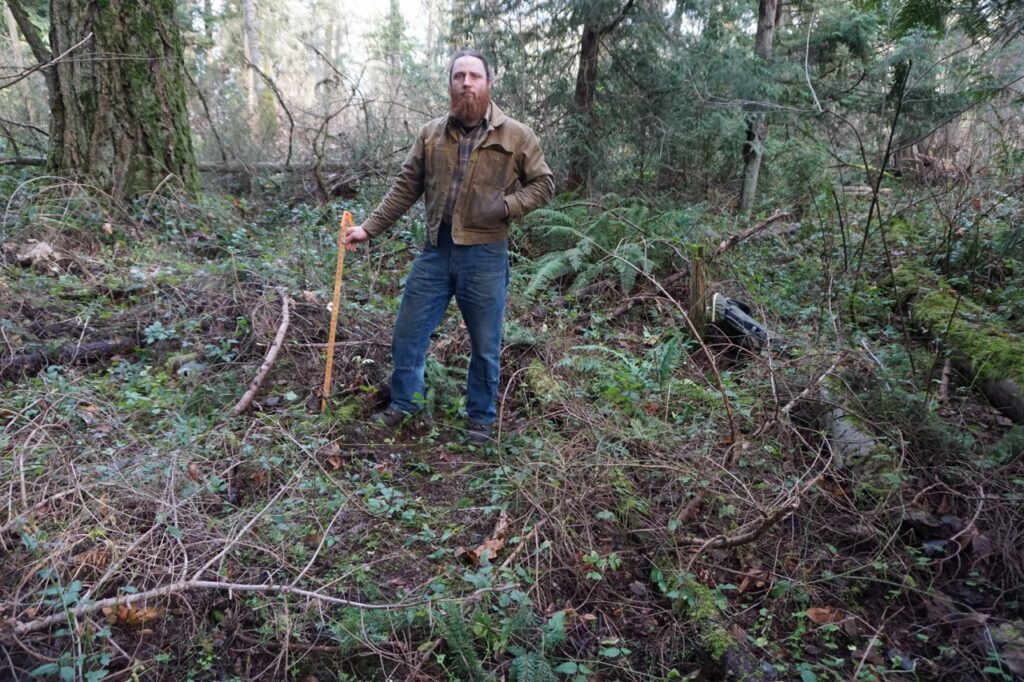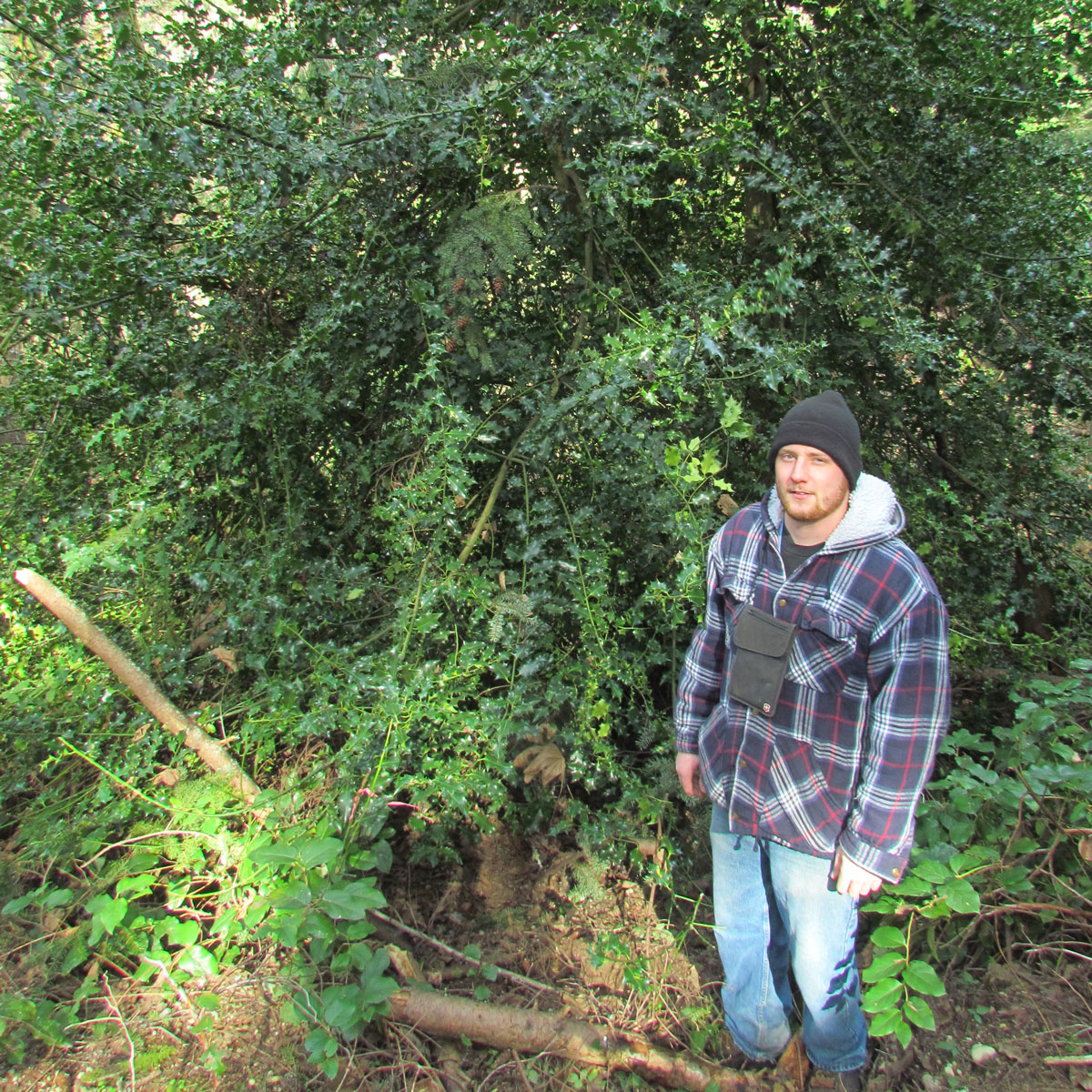Bright red berries. Glossy green leaves. Even if you don’t know English holly by name, you’ve probably run across the evergreen tree, which thrives in the Pacific Northwest. The stuff of Christmas wreaths and hardy suburban hedges, English holly has been cultivated in Western Washington for more than a century.
Despite its festive image, this holly is a proven threat to Northwest forests. The state of Washington recently classified it a Class C noxious weed — thanks in large part to a decade-plus of research by Elliott Church, a 2013 graduate of the University of Washington Bothell.
In a paper he co-authored in the July 2025 issue of Natural Areas Journal, Church demonstrated the harmful side of English holly. “It basically bullies and crowds out competing plants,” he said. “It’s very successful in invading forest understories in our region.”
Church’s investigations took root in a class taught by Dr. David Stokes, now emeritus professor in the School of Interdisciplinary Arts & Sciences. Shortly after his arrival on campus, Stokes was on the lookout for a research project that could involve undergraduates in his ecology and conservation biology courses.
The forest’s shady interior
“It’s a way for students to really grapple with issues in a deeper way than you do in a conventional classroom course,” said Stokes. “Getting out there and actually collecting data, working in a team, analyzing the data — it’s a higher order kind of pursuit.”
He didn’t have to look far for a suitable subject: Walking through Saint Edward State Park, a 15-minute drive from campus, Stokes noticed dark green leaves against the forest’s lighter hues. “English holly popping up everywhere, in places I wouldn’t have expected,” he said.
Back in 2011, most conservation biologists believed that intact forests were less vulnerable to invasion, Stokes said.
There was already plenty of anecdotal commentary about English holly’s invasive qualities. The Washington State Noxious Weed Control Board had considered listing it as a noxious weed but declined to do so. The reason? There was no scientific evidence to back up claims about its invasiveness.
Given the absence of an existing study, Stokes knew he had uncovered a solid research question for his ecology students. “Is the species invasive in our native Pacific Northwest forests,” he asked them, “and if so, what is the nature of that invasion?”

Boots on the ground
Church jumped at the chance to find out.
Under Stokes’s guidance, he and other students converged in Saint Edward State Park to find, sample — and ideally remove — every English holly plant in a 30-acre section of the 300-acre park. To cover every square foot of forest, the undergrads walked in straight lines, ducking under and over obstacles, and climbing up and down hills to take measurements and samples.
Sometimes they pulled up holly saplings; in other spots, they sawed sections from larger ones.
“It really scratched an itch,” Church said. “Doing investigative research with those kinds of methods … good old-fashioned measuring tape and compass and calipers. I really enjoyed the field work.”
Back in the lab, he and fellow students counted tree rings to figure out how old the holly was. Their findings revealed exponential growth of the English holly population in the park. These and subsequent investigations led to “Pictures of an Invasion: English Holly in a Semi-Natural Pacific Northwest Forest,” a 2014 paper documenting the invasive nature of the evergreen. It was co-authored by Stokes; Church; Dr. Santiago Lopez, now a professor in the School of IAS; and David Cronkright, Environmental Science ’12.
“[Research] is a way for students to really grapple with issues in a deeper way … Getting out there and actually collecting data, working in a team, analyzing the data — it’s a higher order kind of pursuit.”
Dr. David Stokes, emeritus professor, School of IAS
The quest continues
But Church still had questions: Maybe holly is invasive, but how do we know it’s having an effect? What exactly is holly doing to understory vegetation?
With Stokes as his adviser, he gained funding through UW Bothell’s Office of Sponsored Research for a project to dig for the answers. Church returned to a section of forest at the park with a new mission: Meticulously quantify the vegetative cover of all native understory species under (and near) a sample of large English holly trees. Unlike the first project, he would investigate the potential impact of invading holly on other species.
His holly research was still underway when Church graduated from UW Bothell in 2013 with degrees in Environmental Science and in Global Studies. He pursued the project throughout his studies in the School of Environmental and Forest Science at the UW in Seattle, where he wrote his 2016 master’s thesis on English holly in managed timber forests.
Still, the investigation wasn’t complete.
After he received his Master of Science, Church went on to full-time work as a municipal arborist, returning to the English holly research whenever he had bandwidth. “It would be a crime to let [the research] disappear into the wind,” he said. “That was never going to happen.”
The path to publication
More than a decade after that first season in Saint Edward State Park, Church, Stokes and Dr. Warren Gold, associate professor in the School of IAS, were ready to submit their latest findings for publication. “Science isn’t just doing the fieldwork or the analysis,” Stokes said. “If you don’t communicate your results, you’re not doing science.”

They aimed high, approaching Natural Areas Journal, a major publication in the field of natural area science and management.
“Often it’s really hard to get a paper over the final hurdle of peer-reviewed publication,” Stokes said. Earlier manuscripts had been turned back by other journals a few times, with reviewers pointing out issues that needed more thought. Church took on the task, doing further reading and analysis to satisfy the reviewers’ questions. The extra work paid off in the form of a stronger final product.
“It’s a fantastic paper as a result of Elliott’s work to respond,” Stokes said. “I just can’t praise him enough for his persistence on this. This isn’t something he was being paid to do.”
Published in July 2025, the paper shows a very strong and consistent correlation between the presence of an English holly canopy and the reduction of important native plants such as salal, sword fern and trailing blackberry. The research also raises questions about the impact of the evergreen on forest regeneration. Can an alder or Douglas fir sapling, for instance, get a foothold under a thicket of holly?
The rewards of research
Even before the paper went public, the Washington State Noxious Weed Control Board was again considering English holly for inclusion on its noxious weed list. Armed with their research, Stokes and Church testified to the board.
This time, the evidence was enough: English holly is now classified as a Class C noxious weed in Washington.
But Church said he still isn’t done with the evergreen. He plans to continue his investigations with a comparison of how English holly grows in deciduous forests versus coniferous ones.
As a researcher working without the support of a lab, he urges current UW Bothell students to take advantage of the plentiful on-campus resources at hand. “Doing your own research to try to contribute something, no matter how small — I think it’s really rewarding and important,” he said.
“Even if you fall short, you’re going to get skills that will help you later on.”




